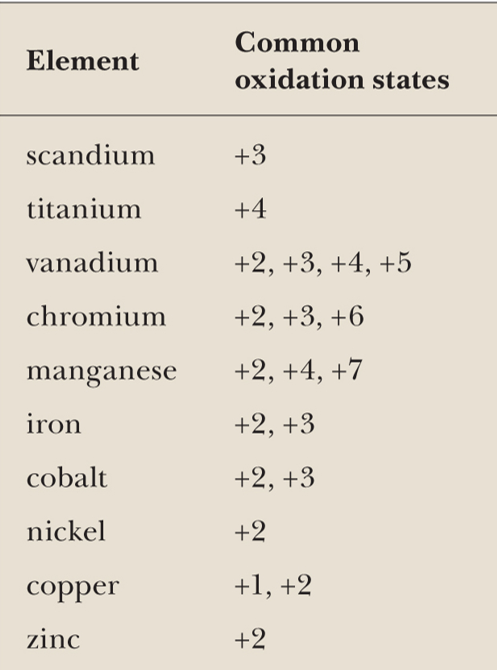d and f Block Elements
Oxidation states
One of the most significant features of transition metals is the wide range of oxidation states (oxidation numbers) that the metals can show. Variable oxidation states are possible because the 4s and 3d sub-levels are very close in energy. It is relatively easy to lose electrons from either of these sub-levels.
Only transition metals can have variable oxidation states would be a wrong statement though. For example, elements like sulphur or nitrogen or chlorine have a very wide range of oxidation states in their compounds and these are not transition metals.

Chemists have noticed that the M3+ ion is more stable from Sc to Cr, but the M2+ ion is more stable oxidation state from Mn to Cu. Consequently, Iron has two common oxidation states (+2 and +3) which form Fe2+ and Fe3+ ions. But it also exists in a less common +6 oxidation state as with the ferrate(VI) ion, FeO42-. Changes in the electronic structure of iron to make the 2+ or the 3+ ion are explained below.
Accordingly, we must note that the 4s orbital and the 3d orbitals have very similar energy level. The amount of energy required to remove the third electron compared with the first and second electron is not as significantly large as the removal of the other two. However, maximum oxidation states increase in steps of +1 until Mn (because of 4s and 3d electrons). From Fi to Zn, the number of states decreases by steps of -1. Likewise, manganese has an elaborate range of oxidation states in its compounds. For example:
References Transition metals in higher oxidation state usually covalently bound to an electronegative element such as O or F. E.g VO3-, vanadate(V) ion; MnO4-, manganate(VII) ion. Simple ions with high OS’s such as V5+ & Mn7+ are not formed. Change from one oxidation state to another is a redox reaction. The relative stability of different oxidation state can be predicted by looking at Standard Electrode Potentials. Higher oxidation state becomes less stable relative to lower ones on moving from left to right across the series. Compounds containing transition metals in high oxidation state tend to be oxidising agents e.g MnO4-. Compounds with transition metals in low oxidation state are often reducing agents e.g V2+ & Fe2+. The relative stability of the +2 state in comparison to +3 state increases across the series. Considering the compounds that are placed early in the series, the +2 state shows a highly reducing property. E.g. V2+(aq) & Cr2+(aq) strong reducing agents. Later in series +2 stable, +3 state highly oxidizing. E.g. Co3+ ion is a strong oxidising agent while Ni3+ & Cu3+ ions do not exist in aqueous solution.
